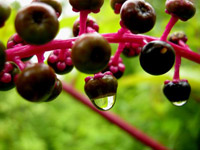Researchers at Wake Forest University’s Center for Nanotechnology and Molecular Materials are trying to achieve source of clean and green power through pokeberries! Pokeberries could be helpful in making solar power accessible to many. Nanotech Center scientists have extracted the red dye from pokeberries to paint their efficient and low-cost fiber-based solar cells. The dye acted in a desirable manner. It acts as an absorber, helping the cell’s minute fibers entrap more sunlight to convert into power.

The good news is pokeberries grows in rocky infertile soil and even during draught period. Even rural Africans can grow it in their existing climate. David Carroll, Ph.D.and the center’s director thinks that dye absorbers can help Africans fight power problems. Carroll emphasizes his point, “They’re weeds. They grow on every continent but Antarctica.”
Wake Forest University had patented the fiber-based photovoltaic, or solar, cells. The patent is granted by the European Patent Office. FiberCell Inc. has received the license to build up manufacturing processes for the new solar cell.
If this project attains success these fiber cells can create twice the power that existing flat-cell expertise can produce. Why? The answer is these cells are composed of millions of tiny, plastic “cans.” These cans catch light until most of it is absorbed. Another great advantage is the fibers have much more surface area. This will help the fiber solar cells to trap light at any angle. This phenomenon can take place from dusk till dawn.
How these solar cells are prepared? Firstly, the plastic fibers are stamped onto plastic sheets. This stamping utilizes the same technology that is used in attaching the tops of soft-drink cans. The second step is spraying of an absorber ( a polymer) or a cheap dye. Another advantage of the plastic cells is they are light in weight and flexible as well. Transporting this solar device to another continent would be easy.
After reaching the desired destination, these solar cells can be sprayed with the dye to enhance its efficiency. Carroll comes out with certain figures. According to him, it would cost around $5 million to install a finishing plant. It would still be $15 million less than it could cost to set up a similar plant for flat cells. He says, “We could provide the substrate. If Africa grows the pokeberries, they could take it home.”
He points out the benefits, “It’s a low-cost solar cell that can be made to work with local, low-cost agricultural crops like pokeberries and with a means of production that emerging economies can afford.”
 Follow
Follow